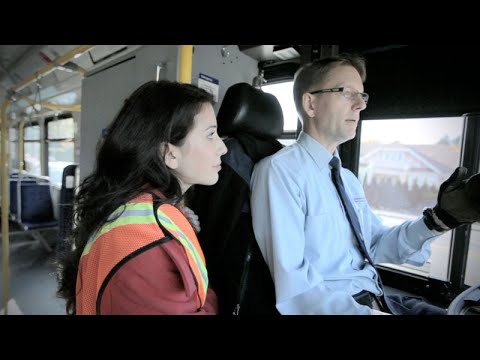Career Overview
People in this career drive buses, subway trains and light rail transit vehicles so that passengers can get from place to place without a car. They drive planned routes on a schedule and people buy tickets to ride on the bus, subway or light rail train.
Bus drivers work for urban transit systems, school boards or transportation authorities and private transportation companies. Subway and light rail transit operators work for urban transit systems.
People in this career must have great driving skills and should be able to follow instructions carefully. They also need to think and act quickly in different situations. Good communication and people skills are important because they speak and deal with passengers throughout their shift.
Job Titles
Duties
Bus drivers:
- Drive buses to take passengers from one place to another on planned routes
- Drive buses to take passengers and goods within a city or town or over long distances
- Drive sightseeing tour buses to transport people to a specific place within a town or city or to take them long distances to other areas
- Drive buses that offer access to people in wheelchairs, and help passengers getting on and off the bus
- Give passengers information on fares, schedules and stops
- Collect fares, give and confirm transfers, check bus passes and record transactions
- Inspect vehicles before and after each trip or shift
- Talk with passengers, dispatchers or other drivers using two-way radio systems or cell phones
- Report delays, mechanical problems and accidents
- May provide information on points of interest during sightseeing tours
- May load and unload passengers’ luggage and express freight
School bus drivers:
- Drive school buses to take children to and from school or on field trips
- Make sure that children are safe when boarding and leaving the bus, including crossing the street while the bus is stopped
- Keep control of what children are doing during travel to ensure safety
- May drive adults on chartered trips outside of school hours
Subway train and light rail transit operators:
- Operate subway or rail transit vehicles as part of two-person crew
- Observe signals at crossings and arrival and departure points
- Operate controls to open and close transit vehicle doors
- Report delays, mechanical or other problems and accidents to the control office
- Oversee passenger safety and welfare in emergencies, and direct passengers during evacuation procedures
Earnings
Earnings is income that workers receive in exchange for their labour. Depending on the type of employment, earnings can be in the form of wages (hourly), salaries (fixed monthly or annual) or self-employed earnings.
Work Environment
# Workers Employed
9,070% Employed Full Time
56%Bus drivers and transit operators spend most of their working day driving vehicles, which usually have comfortable driver seats.
Entry level bus drivers and transit operators can expect to work part time through evenings, weekends and sometimes holidays before working full time. Those who have been in the job longer can expect more regular shifts and full-time hours (40 hours per week). Some in this job work split shifts, which means working for several hours in the morning, having a break for a few hours, and coming back to work for a few more hours.
Public transit operators are more likely to be part of a union and work full time.
As bus drivers and transit operators must sit for long periods, they can get back and neck injuries. These workers may also have to handle angry or upset passengers from time to time.
Career Pathways
Bus drivers often have previous experience as truck drivers. Most workers start by working part time, evenings, weekends and holidays, as well as split shifts before getting a full-time position.
With additional training or experience, people with this career can be promoted to supervisor or manager, or into non-driving jobs such as dispatcher, safety officer or driving trainer.
Occupational Interests
It’s important to understand what kinds of occupations align with your interests.
For more about occupational interests visit Skills for the Future Workforce > Characteristics.
Here are the top occupational interest(s) for this career profile:
Education, Training and Skills
Bus drivers and transit operators must have some secondary school education. However, a high school diploma is generally preferred. They must have a valid Class 5 B.C. driver’s licence or Canadian equivalent. They may also need a Class 2 driver’s licence with airbrake endorsement, and at least one to five years of safe driving experience. In addition, people in this career may need to take on-the-job training that could take up to three months to complete. People in this job need basic first aid training (this may be included in on-the-job training) and have some computer skills.
Education programs in B.C.

Top Skills
Every job calls for a certain set of skills. Knowing those skills is the first step in finding a good career fit.
Here, you will find the 10 most relevant workplace skills. Some are more important to achieving success in a certain career than others. These skills may come naturally to you or you may need to gain them through education, training and experience.
See the list of work-related skills below, ranked in order of importance for this career. Check out the list and see if this career matches your skills—take that first step!
Controlling operations of equipment or systems.
Watching gauges, dials or other indicators to make sure that a machine is working properly.
Giving full attention to what other people are saying, taking time to understand the points being made, asking questions as appropriate, and not interrupting at inappropriate times.
Talking to others to share information effectively.
Keeping track of and assessing your performance, other individuals, or organizations to make improvements or take corrective action.
Actively looking for ways to help people.
Using logic and reasoning to identify the strengths and weaknesses of alternative solutions, conclusions or approaches to problems.
Managing one’s own time and the time of others.
Being aware of others’ reactions and understanding why they react as they do.
Understanding written sentences and paragraphs in work-related documents.
Labour Market Statistics
Discover data, facts and information that have been gathered and analyzed. Learn about the characteristics of the economy and labour market in B.C.
Employment
Find out about employment types and trends by region and industry.
Employment
9,070Employment by Region







| Region | Employment | % Employment of this Occupation |
|---|---|---|
| Cariboo | 310 | 3.4% |
| Kootenay | 270 | 3.0% |
| Mainland/Southwest | 5,975 | 65.8% |
| North Coast and Nechako | 160 | 1.8% |
| Northeast | 185 | 2.0% |
| Thompson-Okanagan | 805 | 8.9% |
| Vancouver Island/Coast | 1,370 | 15.1% |
Labour Market Outlook
The B.C. Labour Market Outlook is a 10-year forecast of the expected supply and demand for labour in the province. It’s usually updated every year. The purpose is to provide British Columbians with the knowledge to make informed decisions on careers, skills training, education and hiring.
Forecasted Job Openings (2025-2035)
3,980Forecasted Job Openings
Forecasted Employment Growth Rate
Composition of Job Openings
Job Openings by Region (2025-2035)







| Region | Job Openings | Avg. Annual Employment Growth |
|---|---|---|
| Cariboo | 60 | -0.5% |
| Kootenay | 100 | 0.6% |
| Mainland/Southwest | 2,800 | 1.2% |
| North Coast and Nechako | 60 | 0.6% |
| Northeast | 80 | 1.0% |
| Thompson-Okanagan | 200 | -0.4% |
| Vancouver Island/Coast | 690 | 1.6% |
Industry Highlights
Learn about the opportunities in B.C.'s major industries, including employment trends, earning potential, locations of work and more.
Forecasted Job Openings by Industry
| Industry | Job Openings (2025-2035) |
|---|---|
| Transportation and Warehousing | 3,330 |
| Educational Services | 330 |
| Retail Trade | 80 |
| Health Care and Social Assistance | 40 |
| Professional, Scientific and Technical Services | 40 |
Insights from Industry
There are usually a lot of applicants for these jobs. Post-secondary education, good communication and people skills are an advantage when applying for this job.
Bus drivers and transit operators work alone, which means that they need to make decisions, take responsibility and do a good job without direct supervision.
People in this job must be patient with passengers who may be confused or lost, as well as in response to traffic, accidents, construction and bad drivers. They need to remain professional and calm even when a passenger is being rude or aggressive.
It’s important for people in this career to always pay attention – anticipating problems on the road or with a passenger.
Resources
-
B.C. Ministry of Transportation and Infrastructurewww2.gov.bc.ca/gov/content/governments/organizational-structure/ministries-organizations/ministries/transportation-and-infrastructure
-
BC Transit – Careerswww.bctransit.com/careers
-
British Columbia Trucking Association – Job Postingswww.bctrucking.com/careers/job-postings
-
Insurance Corporation of British Columbia (ICBC)www.icbc.com
-
TransLink – Careerswww.translink.ca/About-Us/Careers








